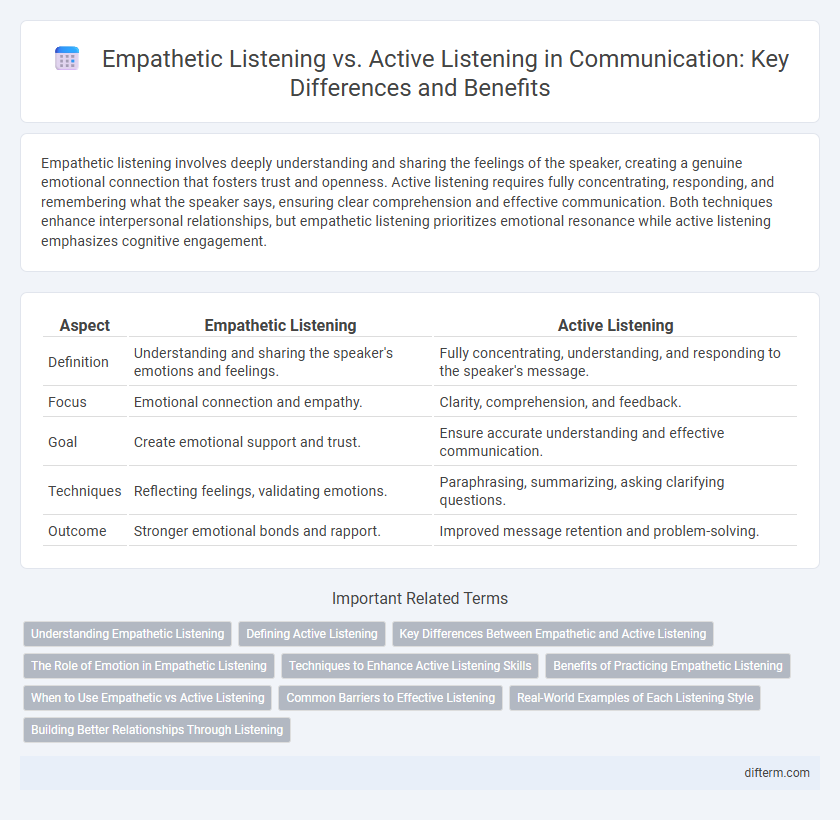Empathetic listening involves deeply understanding and sharing the feelings of the speaker, creating a genuine emotional connection that fosters trust and openness. Active listening requires fully concentrating, responding, and remembering what the speaker says, ensuring clear comprehension and effective communication. Both techniques enhance interpersonal relationships, but empathetic listening prioritizes emotional resonance while active listening emphasizes cognitive engagement.
Table of Comparison
| Aspect | Empathetic Listening | Active Listening |
|---|---|---|
| Definition | Understanding and sharing the speaker's emotions and feelings. | Fully concentrating, understanding, and responding to the speaker's message. |
| Focus | Emotional connection and empathy. | Clarity, comprehension, and feedback. |
| Goal | Create emotional support and trust. | Ensure accurate understanding and effective communication. |
| Techniques | Reflecting feelings, validating emotions. | Paraphrasing, summarizing, asking clarifying questions. |
| Outcome | Stronger emotional bonds and rapport. | Improved message retention and problem-solving. |
Understanding Empathetic Listening
Empathetic listening involves deeply sensing the emotions and perspectives behind the speaker's words, fostering genuine connection and trust. This communication technique prioritizes emotional resonance and validation, enabling listeners to respond with compassion rather than simply processing information. Understanding empathetic listening enhances interpersonal relationships by promoting emotional support and authenticity in conversations.
Defining Active Listening
Active listening involves fully concentrating, understanding, responding, and remembering what is being said in a conversation. It requires the listener to provide feedback through verbal affirmations, paraphrasing, and asking clarifying questions to ensure accurate comprehension. This technique improves communication effectiveness by fostering trust and reducing misunderstandings in personal and professional interactions.
Key Differences Between Empathetic and Active Listening
Empathetic listening involves fully understanding and sharing the feelings of the speaker, creating a deep emotional connection, while active listening emphasizes accurately interpreting and responding to the speaker's message through techniques like paraphrasing and questioning. Key differences include empathetic listening's focus on emotional resonance and validation, contrasted with active listening's goal of clarity and information retention. Both approaches enhance communication but serve distinct purposes: empathetic listening fosters emotional support, while active listening ensures effective information exchange.
The Role of Emotion in Empathetic Listening
Empathetic listening deeply engages with the speaker's emotions, enabling a genuine connection that validates their feelings and experiences. This approach moves beyond mere understanding, creating a safe space where emotions are acknowledged and responded to with compassion. Unlike active listening, which focuses on information processing and clarification, empathetic listening prioritizes emotional resonance to foster trust and emotional healing.
Techniques to Enhance Active Listening Skills
Techniques to enhance active listening skills include maintaining eye contact, providing verbal affirmations like "I understand," and summarizing key points to confirm understanding. Using open body language, avoiding interruptions, and asking clarifying questions improve focus and comprehension during conversations. These methods foster deeper engagement, ensuring that messages are accurately received and responded to.
Benefits of Practicing Empathetic Listening
Practicing empathetic listening strengthens interpersonal relationships by fostering trust and deeper emotional connections, which enhances overall communication effectiveness. It allows individuals to fully understand and validate the speaker's feelings and perspectives, leading to reduced conflicts and improved collaboration. Empathetic listening also promotes emotional intelligence and creates a supportive environment conducive to open dialogue and mutual respect.
When to Use Empathetic vs Active Listening
Empathetic listening is essential during emotionally charged conversations where understanding the speaker's feelings fosters trust and connection. Active listening is most effective in problem-solving or informational exchanges, ensuring accurate comprehension and feedback. Choosing empathetic listening supports emotional validation, while active listening drives clarity and actionable outcomes.
Common Barriers to Effective Listening
Common barriers to effective listening in both empathetic and active listening include distractions, preconceived notions, and emotional biases that hinder understanding. Noise, whether physical or psychological, interrupts focus and reduces the ability to process messages accurately. Overcoming these obstacles is essential for genuine communication, as it facilitates deeper connection and clarity between speaker and listener.
Real-World Examples of Each Listening Style
Empathetic listening is illustrated in counseling sessions where therapists prioritize understanding clients' emotions, creating a safe environment for expression. Active listening occurs in business meetings, as managers paraphrase and ask clarifying questions to confirm comprehension and ensure effective decision-making. These distinct approaches enhance communication by addressing emotional needs or focusing on accurate information exchange depending on the context.
Building Better Relationships Through Listening
Empathetic listening involves understanding and sharing the feelings of the speaker, creating a deep emotional connection that fosters trust and openness. Active listening, characterized by fully concentrating, responding, and remembering, ensures clarity and mutual understanding in conversations. Combining empathetic and active listening techniques enhances communication quality, leading to stronger, more meaningful relationships in both personal and professional contexts.
empathetic listening vs active listening Infographic

 difterm.com
difterm.com